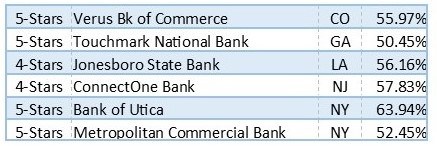
A bank’s Efficiency Ratio measures how much of its operating revenue is spent on overhead, so a lower ratio indicates greater efficiency. According to the FDIC Quarterly Banking Profile (QBP), the average bank efficiency ratio at March 31, 2019 was 55.85%. In other words, during the first quarter 2019, it cost “on average”, 55.85¢ to generate $1 in revenue.
This is one area where efficiencies of scale pay off. Extracting the Big Banks from the equation, it costs a community bank 64 cents, on average, to generate that dollar. The first quarter QBP also shows a big divide between Big Banks and Community Banks in average assets per employee. Again, not a surprise, but we want to concentrate on the 92% of the industry that is comprised of “community banks”.
Average assets per employee at U.S. community banks rose to $5.6 million in the first quarter. But we don’t want average. Not only is our focus this week on community banks, but on the most efficient community banks in the nation. Each bank on page 7 has an efficiency ratio less than 50% AND assets of at least $12.2 million per employee.
With these two measures firmly in the upper percentiles (a higher ratio for assets per employee and a lower ratio for efficiency), net interest margins …and ultimately CD and savings rates could be higher than those of less efficient banks.
This is another difference between Big Banks and community banks. Consumers are much more likely to reap the benefits of higher savings rates at a community bank than at a Big Bank. Big banks rely more heavily on volume and on other investments (i.e. trading, which we will be discussing next week).
Community banks are plain vanilla. And we love vanilla. Deposits come in, loans go out to the betterment of the community. Nothing could be sweeter. The 50 banks listed on page 7 are currently doing that in the most efficient manner. This is not a highly volatile list. In fact, 39 of the 50 also made the list the last time we reported on them, October 22, 2018 (JRN 35:41).
One of the 11 disappearing banks was 5-Star Axos Bank, San Diego, CA, which has historically been extremely efficient, and does have the efficiency ratio (34.68%) to prove it. However, investments it has been making both in organic and acquired businesses have brought its assets per employee down to $10.4 million. With new commercial-banking centers in downtown Los Angeles and Midtown Manhattan, Axos Bank’s assets have grown by $1 billion in the past year. With that growth, its employee count has increased by 25%. It seems the former First Internet Bank has found value in brick and mortar as it positions itself to provide personal access to senior banking officials in those markets to both new and existing clients.
The following disappearing banks now exceed the 50% efficiency ratio cutoff:

And three others were snatched up as they were, not surprisingly, very attractive acquisition targets. That left room for 11 new additions, which we have marked in bold.
New Star-Ratings Next Week
The community banks highlighted in blue are on our survey lists for JRN and/or our consumer CD rate page because they do offer above average CD rates (although at 3-Stars, First Credit Bank in California does not qualify at the moment). We look forward to adding more.
To that end, we always welcome recommendations. If you see an attractive CD rate that’s not listed in JRN, let us know. We’ll check it out and, if all goes well, get it added to our weekly surveys.
Simply call 800.388.6686 or email cdrates@bauerfinancial.com.


